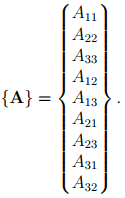Algebra of fourth order tensors
A fourth order tensor A may be thought of as a linear function that maps second order tensor A into another second order tensor B. While this is too narrow a viewpoint1 , it suffices for the study of mechanics. We write B = A : A which defines a linear transformation that assigns a second order tensor B to each second order tensor A.
We can express any fourth order tensor, A in terms of the three Cartesian basis vectors as
A = Aijklei ⊗ ej ⊗ ek ⊗ el , (2.117)
where Aijkl are the Cartesian components of A. Thus, the fourth order tensor A has 34 = 81 components. Remember that any repeated index has to be summed from one through three.
One example for a fourth order tensor is the tensor product of the four vectors u, v, w, x, denoted by u ⊗ v ⊗ w ⊗ x. We have the useful property:
(u ⊗ v) ⊗ (w ⊗ x) = u ⊗ v ⊗ w ⊗ x. (2.118)
If A = u ⊗ v ⊗ w ⊗ x, then it is easy to see that the Cartesian components of A, Aijkl = uivjwkxl , where ui , vj , wk, xl are the Cartesian components of the vectors u, v, w and x respectively.
| 1A fourth order tensor can operate on a vector to yield third order tensor or can operate on a third order tensor to yield an vector. |
Another example of a fourth order tensor, is the tensor obtained from the tensor product of two second order tensors, i.e., D = A ⊗B, where A, B are second order tensors and D is the fourth order tensor. In index notation we may write: Dijkl = AijBkl where Dijkl, Aij , Bkl are the Cartesian components of the respective tensors.
The double contraction of a fourth order tensor A with a second order tensor B results in a second order tensor, denoted by A : B with the property that:
(u ⊗ v ⊗ w ⊗ x) : (y ⊗ z) = (w · y)(x · z)(u ⊗ v), (2.119)
(y ⊗ z) : (u ⊗ v ⊗ w ⊗ x) = (u · y)(v · z)(w ⊗ x). (2.120)
Hence, we can show that the components of A, Aijkl can be expressed as
Aijkl = (ei ⊗ ej ) · A : (ek ⊗ el) = (ei ⊗ ej ) : A · (ek ⊗ el) (2.121)
Next, we compute the Cartesian components of

where Aijkl and Bmn are the Cartesian components of the tensors A and B. Note that B : A ≠ A : B.
Then, the following can be established:
(A ⊗ B) : C = (B · C)A, (2.123)
A : (B ⊗ C) = (A · B)C, (2.124)
where A, B, C and D are second order tensors.
The unique transpose of a fourth order tensor A denoted by At is governed by the identity
B · At : C = C · A : B = A : B · C (2.125)
for all the second order tensors B and C. From the above identity we deduce the index relation (At )ijkl = Aklij . The following properties of fourth order tensors can be established:
(At )t = A, (2.126)
(A ⊗ B)t = B ⊗ A. (2.127)
Next, we define fourth order unit tensors I and II so that

for any second order tensor A. These fourth order unit tensors may be represented by

where (I)ijkl = δikδjl and  ijkl = δilδjk define the Cartesian components of I and
ijkl = δilδjk define the Cartesian components of I and  , respectively. Note that
, respectively. Note that  ≠
≠  t .
t .
The deviatoric part of a second order tensor A may be described by means of a fourth order projection tensor, P where

Thus the components of dev(A) and A are related through the expression [dev(A)]ij = PijklAkl, with Pijkl = δikδjl − (1/3)δijδkl.
Similarly, the fourth order tensors S and W given by

are such that for any second order tensor A, they assign symmetric and skew part of A respectively, i.e.,

Alternate representation for tensors
Till now, we represented second order tensor components in a matrix form, for the advantages that it offers in computing other quantities and defining other operators. However, when we want to study mapping of second order tensor on to another second order tensor, this representation seem to be inconvenient. For this purpose, we introduce this alternate representation. Now, we view the second order tensor as a column vector of nine components instead of a 3 by 3 matrix as introduced in (2.45). The order of these components is subjective. Keeping in mind the application of this is to study elasticity, we order the components of a general second order tensor, A, as,
 (2.134)
(2.134)
In view of this, the fourth order tensor, which for us is a linear function that maps a second order tensor to another second order tensor, can be represented as a 9 by 9 matrix as,

where A and B are second order tensors and C is a fourth order tensor. Note that as before the fourth order tensor has 81 (=9*9) components. Thus, now the fourth order tensor is a matrix which is the reason for representing the second order tensor as vector.
ijkl = δilδjk define the Cartesian components of I and
, respectively. Note that
≠
t .
(2.134)
























